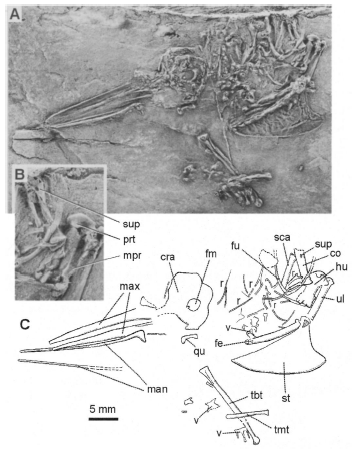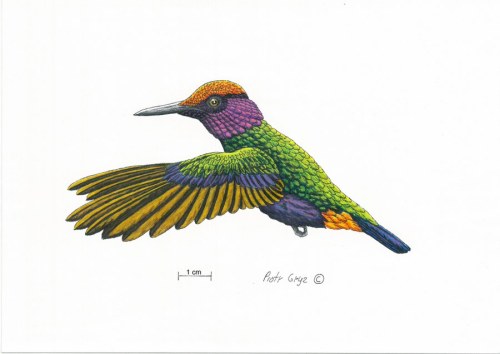Eurotrochilus inexpectatus- the first modern humming birdWhen: Early Oligocene (~30-34 million years
Eurotrochilus inexpectatus- the first modern humming birdWhen: Early Oligocene (~30-34 million years ago)Where: Baden-Württemberg, Germany What: A european hummingbird! Living hummingbirds (family Trochilidae) are found only in the americas, thus it was quite a surprise to find a fossil that is almost a modern humming bird in the Oligocene of Europe. That is the reason behind the species name inexpectatus - this specimen was actually in a museum collection for some time before it was recognized as the important find it is! Eocene age stem hummingbirds had been known from Europe for a while, but these forms all lacked hovering capabilities and some were not specialized nectar feeders. It is these two adaptations in tandem that define the modern hummingbird. It’s known that these fossils are related to humming birds, based on a wide variety of features - perhaps most notable is their extremely small size and relative shortening of all of the bones in the forelimb. There are over 300 species of hummingbird alive today, all found the New World. It was previously surmised that it was not until the lineage migrated to the americas that hummingbirds became both nectar feeders and gained the ability to hover, and thus the clade underwent its great evolutionary radiation shortly thereafter. As Eurotrochilus has been proposed to both be a nectar feeder (based upon its elongated rostrum, upon which an even longer bill would lay) and capable of hovering (based upon detailed examination of the morphology of its wing bones) this specimen forces a re-examination of the mechanisms behind the diversification of hummingbirds. This is a great example of how one fossil can totally change our understanding of the evolutionary history of a large clade. -- source link
Tumblr Blog : dailyfossil.tumblr.com
#theropod#oligocene#vertebrate#paleontology#fossils#europe#hummingbird#fossil

